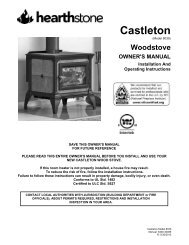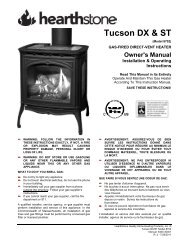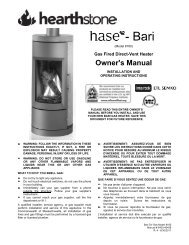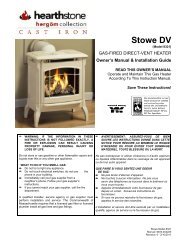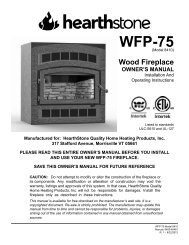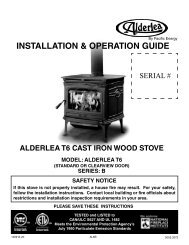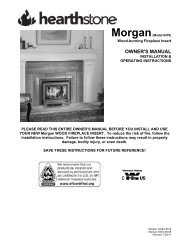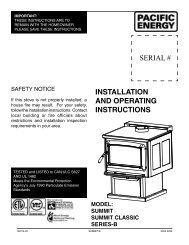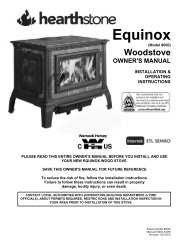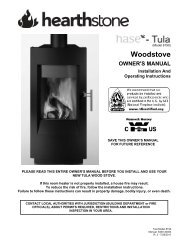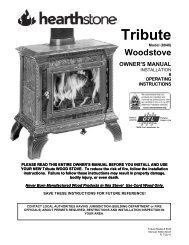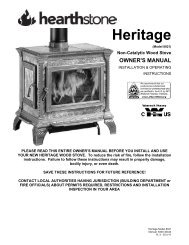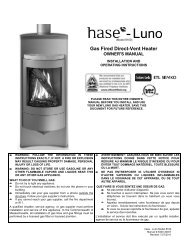Clydesdale 8491 Manual - Hearthstone Stoves
Clydesdale 8491 Manual - Hearthstone Stoves
Clydesdale 8491 Manual - Hearthstone Stoves
You also want an ePaper? Increase the reach of your titles
YUMPU automatically turns print PDFs into web optimized ePapers that Google loves.
<strong>Hearthstone</strong> <strong>Clydesdale</strong> Fireplace Insert Model <strong>8491</strong><br />
hot to the touch. At most, add only a few small<br />
chunks of wood to the fire to reach safe break-in<br />
temperatures.<br />
6. Once the Fireplace Insert is warm but not hot to<br />
the touch, close the primary air control by<br />
pushing it in fully toward the firebox to allow the<br />
fire to die out completely.<br />
7. Let the Fireplace Insert return to room<br />
temperature.<br />
Your first fire and first fire each season thereafter<br />
should be built and maintained as outlined above.<br />
Your patience will be rewarded by a properly<br />
seasoned Fireplace Insert.<br />
Note: Because of the cool flue gas temperatures<br />
present during the break-in procedure, creosote<br />
may build up rapidly. Your door glass may also<br />
get dirty. A good hot fire will clean it. We<br />
recommend a visual inspection (and cleaning if<br />
necessary) of your stovepipe and chimney once<br />
the break-in procedure is completed.<br />
Operating Your Insert Efficiently<br />
<strong>Hearthstone</strong> designed your <strong>Clydesdale</strong> insert to burn<br />
firewood cleanly and efficiently. The following<br />
operational tips explain how to obtain the most heat<br />
possible with minimal creosote build-up and emitted<br />
pollutants.<br />
Burn Rate<br />
There are four basic burn rates: high burn, medium<br />
burn, low burn, and overnight burn. Each has its own<br />
purpose.<br />
High Burn Rate: We recommend a high burn rate<br />
once or twice a day to fully heat the stove and<br />
chimney; this also helps keep the amount of creosote<br />
in your stove and chimney to a minimum.<br />
After the fire is established and both the stove and<br />
chimney are hot, create a high burn for maximum<br />
heat output. Pull the primary air control out so that it’s<br />
fully open or almost fully open. Fully load the firebox<br />
with wood on a bed of hot coals or on an actively<br />
flaming fire.<br />
After you have attained a high burn rate, monitor the<br />
stove temperatures frequently to ensure that the<br />
stove is not over-fired. The surface temperature on<br />
top front of the insert (firebox body under grill) should<br />
not routinely exceed 600°Fahrenheit<br />
(316°Celcius). Once you understand how your<br />
insert burns and heats in your particular setting, you<br />
can easily create a high burn rate without risk to the<br />
stove or chimney.<br />
When your room’s temperature is comfortable,<br />
maintain your fire by loading smaller quantities of<br />
wood. Burning smaller amounts of wood at a high<br />
burn rate creates the least amount of creosote in your<br />
chimney, emits the lowest amount of pollutants, but<br />
provides shorter burn times.<br />
Medium to Medium Low Burn Rate: In general, you<br />
would usually create a medium to medium low burn<br />
rate, especially if your stove is left unattended<br />
periodically. Set the primary air control to a mid-range<br />
setting, appropriate to maintain a comfortable<br />
temperature in the heated area. This setting<br />
produces the most efficient overall burn.<br />
Low Burn Rate: Close the primary air control for a<br />
low burn rate. This setting provides the longest burn<br />
time. However, set a low burn rate only periodically.<br />
Over extended periods, a low burn rate promotes the<br />
accumulation of creosote. If you consistently maintain<br />
low burn rates, inspect your venting system<br />
frequently.<br />
Overnight Burn Rate: An overnight burn, as you<br />
might expect, allows you to keep an area heated<br />
while you sleep. To create an overnight burn, first<br />
ensure the stove and chimney is hot from an<br />
established fire. Next, pull the primary air control fully<br />
open, and then completely load the firebox with<br />
wood. Remember, larger pieces of wood burn longer.<br />
Allow the fire to burn intensely for 20 to 30 minutes.<br />
Finally, push the primary air control close to its lowest<br />
setting; the fire will settle into a lower burn rate with a<br />
small flame and more secondary gas ignition. The fire<br />
will now burn slowly and steadily. The longevity and<br />
intensity of the fire depends on the type, size and<br />
quality of the wood, the strength of the chimney draft,<br />
and other variables that vary from installation to<br />
installation. High draft installations or situations may<br />
require using a low burn rate setting.<br />
In the morning, you should find a bed of hot coals<br />
buried within the ashes. The insert should be warm to<br />
the touch but not hot. To restart the fire without<br />
relighting, simply stir and rake the ashes with a poker<br />
until the hot coals have come to the surface. Place a<br />
handful of kindling and a few small logs on the coals,<br />
close the door, and fully open the primary air control.<br />
The fire should re-ignite within 5 to 10 minutes. Once<br />
the fire is burning well, add a few larger logs, close<br />
the door, leave the primary air control fully open, and<br />
allow the fresh logs to ignite.<br />
Page 24 of 33



